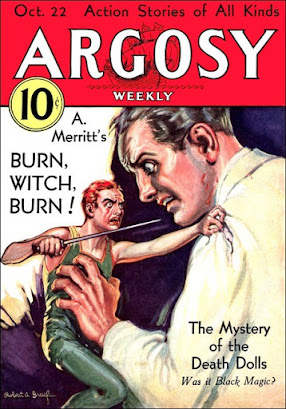That's a shame, in my opinion, because Merritt was an imaginative writer with a unique voice who, in his day, was both successful and well regarded by his peers. He worked most of his adult life as a reporter and editor for a variety of American periodicals. Over the course of his career, he traveled extensively and, in so doing, acquired many mementos of remote locales, including books on esoteric subjects, most of which we'd group under the heading of the occult today.
This should come as no surprise to anyone who has read his works. Black magic and diabolism figure prominently in Merritt's pulp yarns, none more clearly than in his novel Burn, Witch, Burn! Originally serialized in the pages of Argosy over the course of six issues between October 22, 1932 and November 26, 1932, Burn, Witch, Burn! presents itself as a fictionalized account of real events that took place in New York City. The narrator is a medical doctor "specializing in neurology and diseases of the brain" who uses the pseudonym Lowell, in order to avoid identifying his true identity. He adds that all the characters in his tale are real people whose names he has changed for similar reasons.
In the foreword, Dr Lowell states the following:
But now, orthodox man of medicine that I am, I ask myself whether there may not be causes other than those we admit. Forces and energies which we stubbornly disavow because we can find no explanation for them within the narrow confines of our present knowledge. Energies whose reality is recognized in folklore, the ancient traditions, of all peoples, and which, to justify our ignorance, we label myth and superstition.
A wisdom, a science, immeasurably old. Born before history, but never dying nor ever wholly lost. A secret wisdom, but always with its priests and priestesses guarding its dark flame, passing it on from century to century. Dark flame of forbidden knowledge... burning in Egypt before even the Pyramids were raised; and in temples crumbling now beneath the Gobi's sands; known to the sons of Ad whom Allah, so say the Arabs, turned to stone for their sorceries ten thousand years before Abraham trod the streets of Ur of the Chaldees; known in China—and known to the Tibetan lama, the Buryat shaman of the steppes and to the warlock of the South Seas alike.
Dark flame of evil wisdom... deepening the shadows of Stonehenge's brooding menhirs; fed later by hands of Roman legionaries; gathering strength, none knows why, in medieval Europe... and still burning, still alive, still strong.
With the stage now set, Lowell regales the reader with the story of his encounter with Julian Ricori, "a notorious underworld chieftain, one of the finished products of the Prohibition Law." Ricori has a problem that he believes only Lowell can solve: his partner in crime, Peters, has been afflicted with a mysterious ailment, one that leaves him catatonic and completely non-responsive. Ricori offers Dr Lowell a large sum of money, if he can not only discover the cause of the man's affliction but also save his life.
Lowell agrees to help, out of scientific curiosity and concern for the man's health rather than any desire for money. He takes a blood sample, which he examines under a microscope, revealing a single strange, phosphorescent globule inside a leukocyte. Not long thereafter, Peters dies but not before "the chattering laughter of a devil" erupts from him. An autopsy reveals little more about Peters' death. Frustrated, Lowell sets out to see if anyone else in the city has recently died under similar circumstances. He not only finds that there are in fact seven others but they all have something in common: visiting a toy shop run by an old woman named Madame Mandilip.
It's at this point that Burn, Witch, Burn! really takes off. Dr Lowell finds his scientific skepticism challenged again and again, as he is forced to consider the increasingly likely possibility that Madame Mandilip is in fact a witch and that the dolls she sells in her toy shop are enchanted to come alive and kill! If this sounds ridiculous, on some level it is, but Merritt makes it work, largely due to his skill at evoking mood. Burn, Witch, Burn! is a terrific yarn in the pulp tradition.So successful was Burn, Witch, Burn! that it was – loosely – adapted into a movie by Tod Browning (of Dracula fame) in 1936 under the title The Devil-Doll. This was the second Merritt tale turned into a film, the first being the 1929 silent movie, Seven Footprints to Satan, and is generally better regarded, despite the many liberties it takes with the source material. The Devil-Doll is best known for its special effects and its star, Lionel Barrymore, whose character, wholly original to the motion picture, evades capture by his enemies by disguising himself as an old woman named Madame Mandilip. The movie is worth watching primarily as an artifact of its time and as a reminder of how poorly Merritt, like most pulp writers, has been served by Hollywood's attempts to adapt them.



There is another film of Burn, Witch, Burn! although it's in fact an adaptation of Fritz Leiber's story Conjure Wife. Why they decided to give it a new title (the original UK release was Night of the Eagle!) that was the same as a story by a completely different writer is a mystery for the ages.
ReplyDelete